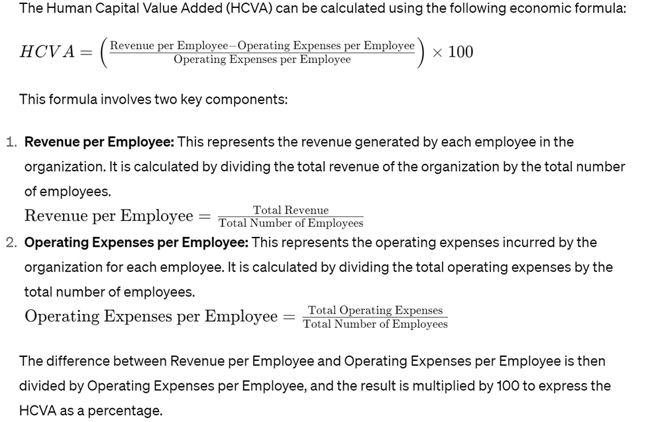Unlocking Business Success: The True Power of Human Capital
Welcome to the 21st century, where organizations are redefining their success by recognizing the true powerhouse behind their achievements – their people. In an era of constant evolution, it's become increasingly evident that the real treasure lies not in products or services, but in the individuals who fuel innovation, productivity, and overall success – their human capital.
To put a finer pint on why such measurement is essential, Ocean Tomo’s 2020 Intangible Asset Market Value (IAMV) study concluded that ‘intangible assets now command 90% of the S&P500 market value.” Much of this asset class is made up of intellectual capital, including employee knowledge, skills, business training, and proprietary information that contributes to an organization’s bottom line and competitive advantage.
To flourish in this ever-changing business landscape, companies are quickly realizing the need to grasp how to create value through their workforce and implement effective measures to gauge and optimize this invaluable resource.
Creating Value Through Human Capital
The journey of creating value through human capital starts with the recruitment and retention of top talent. Organizations are discovering the importance of hiring individuals whose skills, values, and ambitions align seamlessly with the company's mission and goals. This approach ensures employees are contributors and active participants in the organization's unfolding success story.
Fostering a positive workplace culture that encourages collaboration, diversity, and personal development is deemed essential for harnessing the full potential of human capital.
Once the foundation is set, organizations must invest in continuous learning and development programs. These initiatives boost employee morale and equip them with the tools needed to adapt to the fast-paced business environment. This proactive approach enhances individual capabilities and contributes significantly to the organization's overall growth.
Measuring the Human Capital Value
Measuring the value derived from human capital is a nuanced process that transcends traditional performance metrics. While Key Performance Indicators (KPIs) such as productivity and efficiency remain pivotal, organizations are urged to broaden their scope to include factors like employee engagement, satisfaction, and innovation.
Regular feedback mechanisms, surveys, and performance reviews provide valuable insights into the strengths and weaknesses of the workforce, enabling companies to make informed decisions to optimize their human capital.
Leveraging Human Capital Value Add (HCVA)
Enter Human Capital Value Add (HCVA), a crucial metric that quantifies and demonstrates the tangible impact of people on business outcomes. HCVA assesses the financial value an average employee brings to an organization, measuring the profit they generate.
To leverage HCVA effectively, organizations should consider the following strategies:
Linking Human Capital Metrics to Business Performance:
- Identify key performance indicators (KPIs) tied to business success.
- Establish a clear correlation between human capital metrics and identified business KPIs.
Customized Metrics for Industry and Organizational Goals:
- Tailor HCVA metrics to specific organizational and industry needs.
- Develop industry-specific benchmarks to showcase areas of excellence and improvement.
Quantifying the Impact of Employee Development:
- Measure the ROI of training programs by assessing improvements in employee skills.
- Showcase how a well-developed workforce contributes to innovation, efficiency, and adaptability.
Employee Engagement and Retention:
- Connect engagement metrics to organizational performance.
- Demonstrate how high employee engagement contributes to increased productivity and overall organizational resilience.
Utilize Advanced Analytics and Technology:
- Leverage advanced analytics and technology tools for data analysis.
- Implement predictive analytics to forecast future workforce trends.
Communicate Findings Effectively:
- Develop clear reports that highlight the impact of human capital on business value.
- Communicate findings to key stakeholders to build a culture that values human capital.
Continuous Improvement:
- Establish a feedback loop for continuous improvement.
- Adapt metrics and approaches as the business environment evolves.
Measuring Human Capital Value Add (HCVA)
Strategically leveraging measures like HCVA allows organizations to provide concrete evidence of the value their people bring to the business, reinforcing the importance of human capital in achieving sustained success and competitive advantage.

This formula involves two key components:
- Revenue per Employee: This represents the revenue generated by each employee in the organization. It is calculated by dividing the total revenue of the organization by the total number of employees.
Revenue per Employee=Total Number of Employees / Total Revenue - Operating Expenses per Employee: This represents the operating expenses incurred by the organization for each employee. It is calculated by dividing the total operating expenses by the total number of employees.
Operating Expenses per Employee=Total Number of Employees / Total Operating Expenses
The difference between Revenue per Employee and Operating Expenses per Employee is then divided by Operating Expenses per Employee, and the result is multiplied by 100 to express the HCVA as a percentage. This percentage represents the value added by each employee to the organization's revenue, accounting for operating expenses.
A positive HCVA indicates that the revenue generated by each employee exceeds the associated operating expenses, reflecting a positive contribution to the organization's economic value. Conversely, a negative HCVA suggests that the operating expenses per employee are higher than the revenue generated, indicating potential inefficiencies in human capital management.
Creating and measuring value through human capital is a dynamic and holistic journey that encompasses recruitment, development, and advanced analytics. By prioritizing their people and strategically leveraging measures like HCVA, organizations can unlock the true potential of their human capital, paving the way for sustained success and competitiveness in our rapidly evolving business landscape.
If you’d like to talk to us more about measuring the value of human capital in your organization, please drop us a note.

